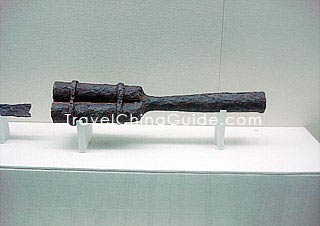In the Northern Song Dynasty (960-1127), gunpowder began to be used in weaponry and the earliest experience in the world. In the Compendium of Military we can determine that there were three production methods for cannonballs which were hurled by a stonejacker as in the Three Kingdoms Period.
In the Southern Song Dynasty (1127 - 1279), Records of Defending Cities by Chen Gui showed the earliest use of flame throwers. People at that time held powder in a thick bamboo tube that spewed fire out of it to burn enemies.
 | | Iron Cannons | |  | | Iron Bombs | |
The shooting fire weapon Huo Chong made of metal came out in the Yuan Dynasty (1271 - 1368). It was the predecessor of firearms. When soldiers used it, they usually foisted powder into the powder chamber, fixed the powder wick and the stones, and then lit to shoot. In the following dynasty Ming (1368-1644), it played an important role in wars and was the most advanced weapon world wide. Huo Chong with larger calibre evolved to be the cannon, and the one with small caliber to be guns.
Although weapons once occupied the top place, they didn't develop much further according to the Training Records (or Lian Bing Shi Ji) by Qi Jiguang cold weapons were still dominant. While after powder spread in the Western world, firearms were quickly employed and until the merchantmen of Spain and Holland brought the latest ones in the late Ming dynasty, the Chinese had not realized their lack of development. The imported cannons in the Qing Dynasty had a high reputation such as 'Great General in Red'. However in the late Qing, it fell again behind during the confrontation between westerners and Chinese.
 | | Iron Grenade, Ming Dynasty | |  | | Three-holed blunderbuss, Ming Dynasty | |
Having suffered the failure of the Opium War in 1840, officials of the Qing Dynasty began to import western weapons and the Chinese weapons industry came to an end. After the foundation of Modern China in 1949, weapons manufacturing has turned over a new leaf and improved as the latest varieties emerge.
- Last updated on Aug. 09, 2022 -



